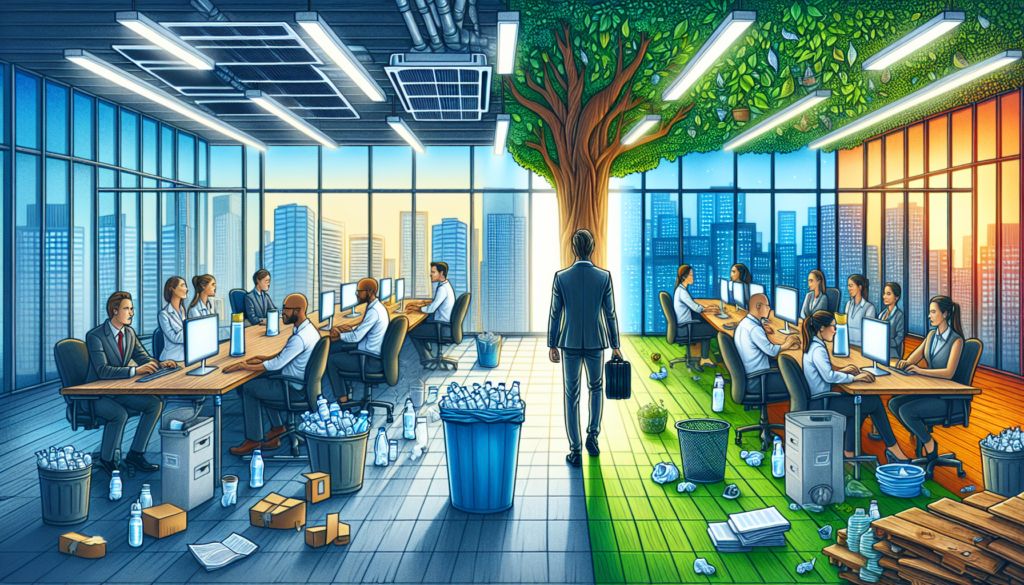In today’s world, workplace sustainability isn’t just a trendy phrase—it’s becoming a must-have. As society grapples with climate change and environmental issues, businesses are waking up to the fact that their actions matter. But who’s really at the helm of this green revolution? Is it the passionate employees eager to make a difference, or the forward-thinking bosses who see the long-term perks of eco-friendly practices?
This article dives deep into the heart of workplace sustainability. It explores what motivates different stakeholders to go green, how to build a sustainable workplace from scratch, and the vital role HR plays in these efforts. It also looks at how technology is shaking things up in the world of eco-friendly practices. By the end, readers will have a clearer picture of who needs the nudge when it comes to sustainability in the workplace—and how everyone can work together to create a greener future.
Understanding the Motivations: Why Sustainability Matters to Different Stakeholders
Sustainability in the workplace isn’t just a passing fad—it’s becoming a necessity. As one delves into the motivations behind this shift, it’s important to explore why it matters to various stakeholders and how it’s shaping the modern workplace.
Employee Perspectives on Workplace Sustainability
Employees are increasingly aware of their environmental impact, and they’re looking to their employers to lead the way. A study showed that 74% of employees find their job more fulfilling when they can make a positive impact on social and environmental issues. What’s more, 70% said they’d be more loyal to a company that helps them contribute to these causes.
This trend is particularly noticeable among younger generations. Millennials, who are set to make up about 75% of the workforce by 2025, are actively seeking employment with socially responsible companies. In fact, 64% of millennials won’t take a job if the employer doesn’t have a strong corporate social responsibility policy.
Management Priorities and Challenges
Sustainability managers face unique challenges in driving adoption across the organisation. One of the main hurdles is that sustainability is often seen as separate from business as usual. They struggle with promoting sustainability in terms the wider business recognises, and there’s often a mismatch between short-term business planning and the longer-term nature of sustainability programmes.
External Pressures and Opportunities
External stakeholders also play a crucial role in shaping sustainability efforts. Stakeholder theory suggests that firm behaviour is influenced by various groups who can affect or be affected by operations. This includes customers, suppliers, and the broader community.
It’s been observed that larger firms often face greater environmental pressures than smaller ones. However, this also presents opportunities. By adopting eco-friendly practices, organisations can reduce their carbon footprint, conserve natural resources, and potentially save on energy costs.
Building a Sustainable Workplace from the Ground Up
Building a sustainable workplace requires a strategic approach that involves assessing current practices, developing a comprehensive strategy, and implementing sustainable infrastructure and processes. Let’s explore each of these steps to create a more environmentally conscious and efficient workplace.
Assessing Current Practices and Setting Baselines
To begin the journey towards sustainability, it’s necessary to take stock of the current situation. This involves reviewing current circumstances and establishing a baseline. Questions to consider include: Have the right targets been set to achieve goals? Are processes delivering results? Are stakeholders engaged?
By looking back before looking forward, one can identify what has and hasn’t worked, and more importantly, why. This assessment helps determine the best course forward and sets the stage for creating a successful strategy.
Developing a Comprehensive Sustainability Strategy
Once a baseline has been established, it’s time to develop a comprehensive sustainability strategy. It’s crucial to be highly selective in determining where to focus attention. Priority goals should centre around issues that are ‘material’ and core to the organisation.
Organisations ask themselves: What will affect their growth, costs, and risks? What matters to their investors, customers, supply chain, and other stakeholders? It’s essential to concentrate on just one or two key sustainability issues to avoid overwhelming themselves and risking poor performance across the board.
Implementing Sustainable Infrastructure and Processes
With a strategy in place, organisations move on to implementation. This involves setting measurable targets, collecting verified data, and monitoring progress. They need to develop action plans and governance processes to achieve these targets.
For instance, IMI plc, a global manufacturing company, gathers uniform data across various sites to create benchmarks and key performance indicators (KPIs). This allows them to compare the carbon intensity of different locations and identify areas for investment in low-carbon technologies.
Organisations have learned that implementation requires processes, which should be optimised by adopting efficient arrangements integrated within existing management systems. Instead of starting from scratch, they adapt, refine, and utilise the systems and processes already in place, such as environmental management systems, health and safety protocols, or procurement procedures.
By establishing sustainable processes – from evaluating waste production and energy consumption in quality audits to incorporating community investment into employee development – organisations can deliver lasting change. A key enabler in achieving sustainability goals is integrating sustainability and ethical factors into procurement decision-making.
It’s important to remember that building a sustainable workplace is an ongoing journey that requires continuous effort and adaptation. By following these steps and involving both employees and C-suite executives, organisations can advance the sustainability agenda and create a workplace that’s not only environmentally conscious but also more efficient and resilient.
The Role of HR in Driving Sustainability Efforts
HR plays a crucial role in driving sustainability efforts within organisations. As companies move towards a more sustainable future, there’s a shift in how they approach recruitment, training, and performance management.
Recruiting for Sustainability Mindset
There’s a growing trend among job seekers, particularly millennials and Gen-Z workers, who prioritise sustainability when choosing an employer. In fact, 70% of job seekers are more likely to work for a company with a strong environmental agenda. This shift has prompted organisations to adapt their recruitment strategies, with 36% of HR departments globally now focusing on their business’ social and environmental stance.
Incorporating Sustainability into Training and Development
Sustainability training is essential for employees. It helps define what sustainability means to a company and supports decision-making processes. Organisations are implementing various training options, from in-person courses to online and hybrid delivery methods, to ensure their teams have the knowledge and skills to address pressing sustainability issues.
Performance Management and Sustainability Metrics
Companies are integrating sustainability into their performance management systems. They’re monitoring key performance indicators (KPIs) related to sustainability, just as they do with financial KPIs. These include environmental metrics like CO2 emissions reduction and energy consumption, as well as social metrics such as employee welfare and diversity. By measuring these aspects, organisations can track progress, evaluate the effectiveness of their actions, and drive improvement in their sustainability efforts.
Leveraging Technology for Sustainable Workplace Practices
Technology is revolutionising the approach to sustainability in the workplace. From digital tools that enhance monitoring and reporting to innovative solutions for resource conservation, there’s a shift in how organisations manage their environmental impact.
Digital Tools for Monitoring and Reporting
Organisations are embracing digital tools that have transformed their ability to collect and analyse environmental data. These platforms enable them to monitor their workplace and other sites using sensors with threshold alarms and alerts, providing real-time environmental data. This 24/7 visibility into operations allows companies to reduce their ecological impact and improve their sustainability policies.
Research has shown that remote work can significantly reduce carbon emissions. Full-time remote employees can cut their emissions by 54% compared to office-based workers. However, the benefits of hybrid work are less clear. Working remotely one day a week only reduces emissions by 2%, whilst two to four days can decrease emissions by up to 29%.
Innovative Solutions for Resource Conservation
Organisations are exploring innovative technologies to conserve resources. For example, the Connected Mangroves project utilises connected devices to support coastal communities’ reforestation efforts. Solar-powered sensors measure environmental conditions affecting mangrove health, helping local communities adjust plant and soil conditions.
Conclusion
Sustainability in the workplace is no longer just a trend; it has become essential for businesses to thrive in today’s environmentally conscious world. This exploration has demonstrated that both employees and management play crucial roles in driving this change forward. Younger generations, in particular, are increasingly seeking out companies with strong sustainability practices, whilst management faces the challenge of integrating these practices into core business operations. The input from over 40 sustainability experts across various industries underscores the importance of employee participation coupled with C-suite backing to advance the sustainability agenda.
To create a truly sustainable workplace, organisations need to assess their current practices, develop comprehensive strategies, and implement sustainable infrastructure and processes. HR departments are taking on a pivotal role by recruiting for a sustainability mindset, incorporating eco-friendly practices into training programmes, and integrating sustainability metrics into performance management. Technology is also having a significant impact on sustainable workplace practices, from digital tools for monitoring and reporting to innovative solutions for resource conservation. To learn how to engage employees in your sustainability efforts, contact KORA today.
FAQs
Who holds responsibility for sustainability within a company?
Top-level management, including CEOs, executives, and directors, play a critical role in the success of a company’s sustainability efforts. They are pivotal in setting key goals and allocating the necessary resources to achieve these objectives.
What part do employees play in achieving sustainability?
Employees are essential in implementing and sustaining a company’s sustainability strategies. The greater the support and enthusiasm from the workforce, the more achievable the goals, such as attaining B corp certification or other green credentials, become.
What are the main motivators behind sustainability in businesses?
A recent webinar highlighted three primary business motivators for sustainability: legal, moral, and commercial. These drivers are pushing companies to integrate sustainability practices into their everyday operations.
What does sustainability mean in the context of the workplace?
A sustainable workplace is one that utilises resources in a manner that minimises environmental impact and promotes the health of its employees. Benefits of such a workplace include reduced environmental footprint, decreased waste, enhanced recycling efforts, improved employee health, and a more amicable and productive working environment.




